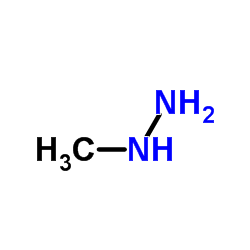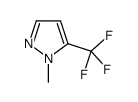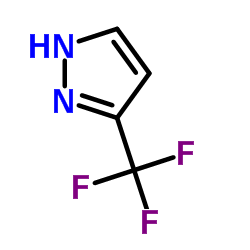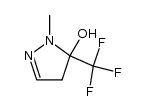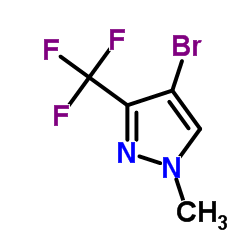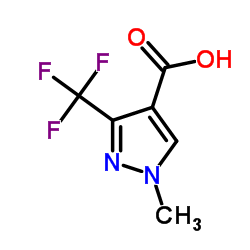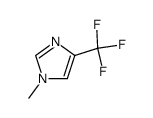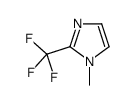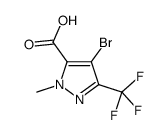154471-65-5
| Name | 1-Methyl-3-(trifluoromethyl)-1H-pyrazole |
|---|---|
| Synonyms |
1H-Pyrazole, 1-methyl-3-(trifluoromethyl)-
MFCD00179867 1-Methyl-3-(trifluoromethyl)-1H-pyrazole 1-methyl-3-(trifluoromethyl)pyrazole |
| Density | 1.3±0.1 g/cm3 |
|---|---|
| Boiling Point | 137.7±35.0 °C at 760 mmHg |
| Molecular Formula | C5H5F3N2 |
| Molecular Weight | 150.102 |
| Flash Point | 37.1±25.9 °C |
| Exact Mass | 150.040482 |
| PSA | 17.82000 |
| LogP | 1.14 |
| Vapour Pressure | 8.6±0.2 mmHg at 25°C |
| Index of Refraction | 1.444 |
Synonym: Section 2 - COMPOSITION, INFORMATION ON INGREDIENTS
Risk Phrases: None Listed. Section 3 - HAZARDS IDENTIFICATION EMERGENCY OVERVIEW
Not available. Potential Health Effects Eye: May cause eye irritation. Skin: May cause skin irritation. May be harmful if absorbed through the skin. Ingestion: May cause irritation of the digestive tract. May be harmful if swallowed. Inhalation: May cause respiratory tract irritation. May be harmful if inhaled. Chronic: Not available. Section 4 - FIRST AID MEASURES Eyes: Flush eyes with plenty of water for at least 15 minutes, occasionally lifting the upper and lower eyelids. Get medical aid. Skin: Get medical aid. Flush skin with plenty of water for at least 15 minutes while removing contaminated clothing and shoes. Ingestion: Get medical aid. Wash mouth out with water. Inhalation: Remove from exposure and move to fresh air immediately. Notes to Physician: Treat symptomatically and supportively. Section 5 - FIRE FIGHTING MEASURES General Information: As in any fire, wear a self-contained breathing apparatus in pressure-demand, MSHA/NIOSH (approved or equivalent), and full protective gear. Extinguishing Media: Use water spray, dry chemical, carbon dioxide, or chemical foam. Section 6 - ACCIDENTAL RELEASE MEASURES General Information: Use proper personal protective equipment as indicated in Section 8. Spills/Leaks: Absorb spill with inert material (e.g. vermiculite, sand or earth), then place in suitable container. Section 7 - HANDLING and STORAGE Handling: Avoid breathing dust, vapor, mist, or gas. Avoid contact with skin and eyes. Storage: Store in a cool, dry place. Store in a tightly closed container. Section 8 - EXPOSURE CONTROLS, PERSONAL PROTECTION Engineering Controls: Use adequate ventilation to keep airborne concentrations low. Exposure Limits CAS# 154471-65-5: Personal Protective Equipment Eyes: Not available. Skin: Wear appropriate protective gloves to prevent skin exposure. Clothing: Wear appropriate protective clothing to prevent skin exposure. Respirators: Follow the OSHA respirator regulations found in 29 CFR 1910.134 or European Standard EN 149. Use a NIOSH/MSHA or European Standard EN 149 approved respirator if exposure limits are exceeded or if irritation or other symptoms are experienced. Section 9 - PHYSICAL AND CHEMICAL PROPERTIES Physical State: Liquid Color: Not available. Odor: Not available. pH: Not available. Vapor Pressure: Not available. Viscosity: Not available. Boiling Point: 82 deg C Freezing/Melting Point: Not available. Autoignition Temperature: Not available. Flash Point: Not available. Explosion Limits, lower: Not available. Explosion Limits, upper: Not available. Decomposition Temperature: Solubility in water: Specific Gravity/Density: Molecular Formula: C5H5F3N2 Molecular Weight: 150.1 Section 10 - STABILITY AND REACTIVITY Chemical Stability: Not available. Conditions to Avoid: Incompatible materials. Incompatibilities with Other Materials: Strong oxidizing agents. Hazardous Decomposition Products: Nitrogen oxides, carbon monoxide, carbon dioxide, fluorine, hydrogen fluoride gas. Hazardous Polymerization: Has not been reported. Section 11 - TOXICOLOGICAL INFORMATION RTECS#: CAS# 154471-65-5 unlisted. LD50/LC50: Not available. Carcinogenicity: 1-Methyl-3-(trifluoromethyl)-1H-pyrazole - Not listed by ACGIH, IARC, or NTP. Section 12 - ECOLOGICAL INFORMATION Section 13 - DISPOSAL CONSIDERATIONS Dispose of in a manner consistent with federal, state, and local regulations. Section 14 - TRANSPORT INFORMATION IATA No information available. IMO No information available. RID/ADR No information available. Section 15 - REGULATORY INFORMATION European/International Regulations European Labeling in Accordance with EC Directives Hazard Symbols: Not available. Risk Phrases: Safety Phrases: S 24/25 Avoid contact with skin and eyes. WGK (Water Danger/Protection) CAS# 154471-65-5: No information available. Canada None of the chemicals in this product are listed on the DSL/NDSL list. CAS# 154471-65-5 is not listed on Canada's Ingredient Disclosure List. US FEDERAL TSCA CAS# 154471-65-5 is not listed on the TSCA inventory. It is for research and development use only. SECTION 16 - ADDITIONAL INFORMATION N/A |
| Hazard Codes | Xi |
|---|---|
| Safety Phrases | S22-S24/25 |
| HS Code | 2933199090 |
|
~48% 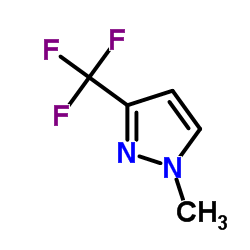
154471-65-5 |
| Literature: Schlosser, Manfred; Volle, Jean-Noel; Leroux, Frederic; Schenk, Kurt European Journal of Organic Chemistry, 2002 , # 17 p. 2913 - 2920 |
|
~% 
154471-65-5 |
| Literature: SOLVAY SA; BRAUN, Max Josef; FISCHER, Reiner Patent: WO2013/167586 A1, 2013 ; Location in patent: Page/Page column 10 ; |
|
~% 
154471-65-5 |
| Literature: Bioorganic and Medicinal Chemistry Letters, , vol. 15, # 22 p. 4898 - 4906 |
|
~51% 
154471-65-5 |
| Literature: Journal of Heterocyclic Chemistry, , vol. 39, # 5 p. 1025 - 1027 |
|
~70% 
154471-65-5
Detail
|
| Literature: Journal of Heterocyclic Chemistry, , vol. 40, # 6 p. 1087 - 1089 |
| Precursor 4 | |
|---|---|
| DownStream 7 | |
| HS Code | 2933199090 |
|---|---|
| Summary | 2933199090. other compounds containing an unfused pyrazole ring (whether or not hydrogenated) in the structure. VAT:17.0%. Tax rebate rate:13.0%. . MFN tariff:6.5%. General tariff:20.0% |



